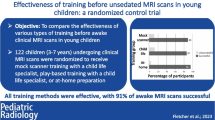Abstract
Background
A number of children are unable to comply with an MRI procedure and require general anesthetic. However, we lack information about which factors are associated with MRI compliance in young children.
Objective
To determine the strongest predictors of MRI compliance, focusing on variables that can be easily rated by patients’ parents.
Materials and methods
A sample of 205 children ages 3–11 years (mean age 6.6 years) who were at risk of non-compliance were recruited from a children’s hospital. Their parents completed a behavior assessment scale for children as well as a questionnaire that assessed their expectations of compliance and perception of their child’s typical medical compliance. The children subsequently completed a mock MRI with an educational play therapist and a clinical MRI, with the quality of the scan scored by the MRI technologist.
Results
Overall, 88.3% of children complied with the clinical scan and achieved diagnostic images, with age unrelated to compliance in this well-prepared patient group. The strongest predictors of MRI compliance were parental expectations and ratings of how well the child typically copes with medical procedures. Non-compliance was related to child attention problems and to poor adaptability among children. A total of 64 preschool-age children (91.4%) and 110 school-age children (95.7%) were correctly classified as compliant or non-compliant based on these predictor variables.
Conclusion
A child’s temperament, medical experiences and parental expectations provide important information in predicting which children successfully comply with an MRI procedure and which require general anesthesia. Further study is needed to explore the utility of these variables in predicting compliance at sites that do not have access to an MRI simulator.
Similar content being viewed by others
References
Marshall SP, Smith MS, Weinberger E (1995) Perceived anxiety of pediatric patients to magnetic resonance. Clin Pediatr 34:59–60
Tyc VL, Fairclough D, Fletcher B et al (1995) Children’s distress during magnetic resonance imaging procedures. Child Health Care 24:5–19
Hallowell LM, Stewart SE, de Amorim E et al (2007) Reviewing the process of preparing children for MRI. Pediatr Radiol 38:271–279
Murat I, Constant I, Maud’huy H (2004) Perioperative anaesthetic morbidity in children: a database of 24,165 anaesthetics over a 30-month period. Paediatr Anaesth 14:158–166
De Amorim E, Silva CJT, Mackenzie A et al (2006) Practice MRI: reducing the need for sedation and general anaesthesia in children undergoing MRI. Australas Radiol 50:319–323
Carter AJ, Greer M-LC, Gray SE et al (2010) Mock MRI: reducing the need for anaesthesia in children. Pediatr Radiol 40:1368–1374
Davidson AJ, Shrivastava PP, Jamsen K et al (2006) Risk factors for anxiety at induction of anesthesia in children: a prospective cohort study. Pediatr Anesth 16:919–927
Kain ZN, Mayes LC, Caldwell-Andrews AA et al (2006) Predicting which children benefit most from parental presence during induction of anesthesia. Pediatr Anesth 16:627–634
Klosky JL, Tyc VL, Tong X et al (2007) Predicting pediatric distress during radiation therapy procedures: the role of medical, psychosocial, and demographic factors. Pediatrics 119:e1159–e1166
Fielding D, Duff A (1999) Compliance with treatment protocols: interventions for children with chronic illness. Arch Dis Child 80:196–200
Bijttebier P, Vertommen H (1998) The impact of previous experience on children’s reactions to venepunctures. J Health Psychol 3:39–46
Proczkowska-Björklund M, Svedin CG (2004) Child related background factors affecting compliance with induction of anaesthesia. Pediatr Anesth 14:225–234
Edwards AD, Arthurs OJ (2011) Paediatric MRI under sedation: is it necessary? What is the evidence for the alternatives? Pediatr Radiol 41:1353–1364
Reynolds CR, Kamphaus RW (2004) Behavior assessment system for children second edition manual. Pearson, Minneapolis
Tabachnick BG, Fidell LS (1996) Using multivariate statistics, 3rd edn. Harper Collins, New York
Comrey AL, Lee HB (1992) A first course in factor analysis, 2nd edn. Hillsdale, New York
Pressdee D, May L, Eastman E et al (1997) The use of play therapy in the preparation of children undergoing MR imaging. Clin Radiol 52:945–947
Rosenberg DR, Sweeney JA, Gillen JS et al (1997) Magnetic resonance imaging of children without sedation: preparation with simulation. J Am Acad Child Adolesc Psychiatry 36:853–859
Epstein JN, Casey BJ, Tonev ST et al (2007) Assessment and prevention of head motion during imaging of patients with attention deficit hyperactivity disorder. Psychiatry Res 155:75–82
De Bie HMA, Boersma M, Wattjes MP et al (2010) Preparing children with a mock scanner training protocol results in high quality structural and functional MRI scans. Eur J Pediatr 169:1079–1085
Acknowledgments
The authors wish to thank Professor Michael Ditchfield for facilitating this project in the Royal Children’s Hospital, Melbourne, Australia, the educational play therapists and MRI technicians for their assistance in recruiting participants and collecting data, and Melanie Kiehne for data entry. The authors are grateful to the patients and their families who took part in this study.
Conflicts of interest
None
Author information
Authors and Affiliations
Corresponding author
Rights and permissions
About this article
Cite this article
Cahoon, G.D., Davison, T.E. Prediction of compliance with MRI procedures among children of ages 3 years to 12 years. Pediatr Radiol 44, 1302–1309 (2014). https://doi.org/10.1007/s00247-014-2996-y
Received:
Revised:
Accepted:
Published:
Issue Date:
DOI: https://doi.org/10.1007/s00247-014-2996-y




